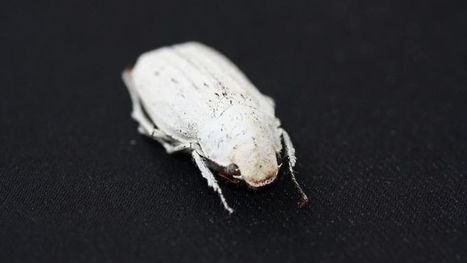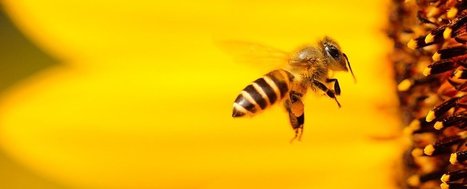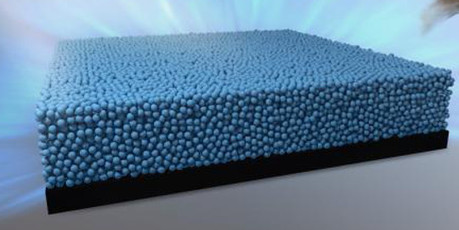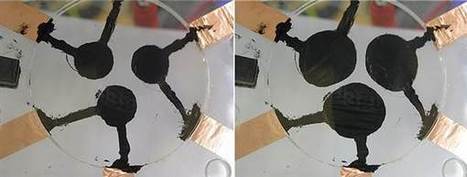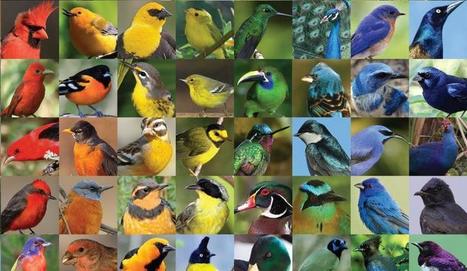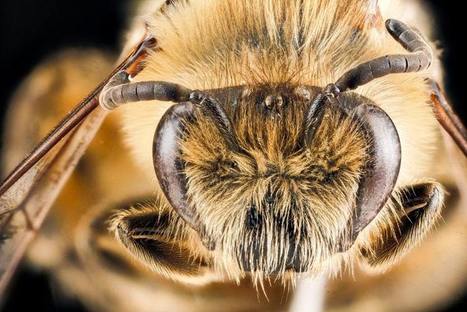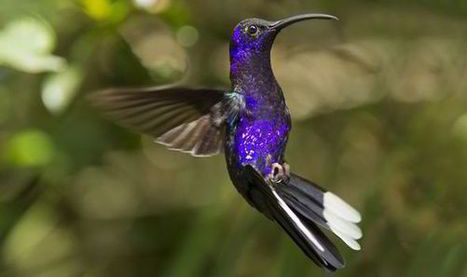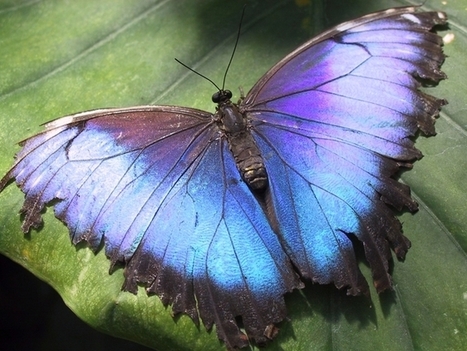 Your new post is loading...
 Your new post is loading...
"Scientists have engineered perhaps the whitest natural substance, using the same physics behind one ghostly white Southeast Asian beetle. White and black feel like opposites for a reason. Black-colored things absorb nearly all of the light that strikes their surface, while white things send the light back, scattered equally at all wavelengths. A team of European scientists have essentially created the whitest paper using this physical property."
"New research on how bees perceive colour could be put to good use in our digital cameras, meaning photos shot by drones or phones would look more natural than ever. It's all to do with colour constancy, the way that bees (and humans) can tell a flower is red no matter what the colour or quality of the light – a mental trick that the digital cameras of today really struggle with."
"Bright colors in the natural world often result from tiny structures in feathers or wings that change the way light behaves when it’s reflected. This structural color is responsible for the vivid hues of birds and butterflies. Artificially harnessing this effect could allow us to engineer new materials for applications such as solar cells and chameleon-like adaptive camouflage. Inspired by the deep blue coloration of a native North American bird, Stellar’s jay, a team at Nagoya University reproduced the color in their lab, giving rise to a new type of artificial pigment. “The Stellar’s jay’s feathers provide an excellent example of angle-independent structural color,” says Yukikazu Takeoka, “This color is enhanced by dark materials, which in this case can be attributed to black melanin particles in the feathers.”
The shifting colors on the skin of cuttlefish and other cephalopods could lead to bio-inspired camouflage and signalling, researchers say.
"Most of us were born and will die a certain color, but octopuses are masters of their hue, changing from transparent to shades of red, pink, purple and blue by stretching and relaxing their skin. If we could unlock their secret and wrap our buildings in octopus skin, then city skylines might shimmer a spectrum of colors and opacities as the sun waxed and waned."
"Researchers at the University of California at Berkeley announced today that they have developed an ultra-thin material that can change color on demand by bouncing back light on the nanoscale level. Well, the on-demand element is a little more nuanced. The “chameleon skin” material actually changes color when flexed, or when a small amount of force is applied to the surface."
"PenTile® technology is biomimetic, meaning it is designed to compliment the complex mechanics of the eye-brain system. As a simple example of eye mechanics consider how the eye utilizes the color blue. The eye has cone receptors that sense color and brightness, and discern patterns. These cones are sensitive to different wavelengths of color—primarily red, green, and blue. The blue cones detect mostly color (chroma) information, while the red and green cones do most of the work resolving images by discerning luminance, edges, and structural details of images, as well as contributing to color vision. The red and green cones are used independently, each cone seeing a "dot" of black and white—ignoring its color to produce high resolution luminance perception—and are used in opposition, comparing the amount of red versus green, to produce low resolution color perception. The PenTile RGBW™ layout uses each red, green, blue and white subpixel to present high-resolution luminance information to the red and green cones, while using the combined effect of all the color subpixels to present lower-resolution chroma (color) information to all three cone types. Combined, this optimizes the match of display technology to the biological mechanisms of human vision." Photo details: Brown eyes, 2007 by Alecgarci 149. Licensed under Public Domain via Wikimedia Commons.
"The little Cyphochilus beetle from Thailand is strikingly white – whiter by far than is common in nature. Researchers from the UK and Italy have now discovered how the very structure of its shell allows the beetle to be both ultra-white and ultra-light."
Industry and consumer awareness of biomimetics is on the rise as demand for naturals continues to climb, with the combination of science and nature increasingly appealing for skin care products.
"Just as a chameleon can instantly morph its skin color to match its surroundings, a new method of controlling crystals using light and chemistry could make clothing or cars change color on demand. The method involves shining a laser on tiny latex particles to make them assume a 3-D crystalline shape or pattern, such as a letter M. When the laser is switched on or off, the crystals appear or disappear."
"New research conducted by marine biologists reveals that the mantis shrimp Haptosquilla trispinosa uses a unique color vision system. [...] «Modern cameras struggle with the amount of data they take in due to increased pixel numbers. Maybe there is a more efficient way and the bio-inspiration provided by the shrimp could be the answer», Ms Thoen [lead author of study] concluded."
"Butterfly wings can do remarkable things with light, and humans are still trying to learn from them. Physicists have now uncovered how subtle differences in the tiny crystals of butterfly wings create stunningly varied patterns of color even among closely related species. The discovery, reported today in the Optical Society's (OSA) open-access journal Optical Materials Express, could lead to new coatings for manufactured materials that could change color by design, if researchers can figure out how to replicate the wings' light-manipulating properties."
"A Canadian company is fighting counterfeiters by employing one of the most sophisticated structures in nature: a butterfly wing. To be precise, Nanotech Security Corp. in Vancouver is using the natural structure of the wings of a Morpho butterfly, a South American insect famous for its bright, iridescent blue or green wings, to create a visual image that would be practically impossible to counterfeit. The technology was developed at British Columbia’s Simon Fraser University, and licensed to the company."
|
Birds display a rainbow palette of colors, many of which come from special arrangements of melanin, the pigment that gives color to our skin. Researchers at the University of Akron have developed a safe and stable pigment based on the melanin structures.
One area where biomimicry is yielding fascinating results is in the field of optics and machine vision. While our cameras and ways of thinking about sight have largely been informed by the human visual system, cutting-edge research is looking to insects to find new tricks for everything from depth perception to colour analysis.
"At least 40 species of tarantulas come in shades of blue. [...] To find out more about the "tarantula blue," researchers used different microscopy techniques to analyze tarantula hairs. They found that although these species share a shade of blue, tarantulas don't use pigments to produce it. Instead, the blue colors are produced thanks to nanostructures in the spiders' hair, which reflect blue light. And these nanostructures differ between species, the scientists found. Most importantly, however, these blue colors don’t change intensity or hue as the viewing angle changes. That's a big differentiator from the highly iridescent structural colors seen in most birds, butterflies, and beetles."
"Inspired by the way iridescent bird feathers play with light, scientists have created thin films of material in a wide range of pure colors — from red to green — with hues determined by physical structure rather than pigments. Structural color arises from the interaction of light with materials that have patterns on a minute scale, which bend and reflect light to amplify some wavelengths and dampen others. Melanosomes, tiny packets of melanin found in the feathers, skin and fur of many animals, can produce structural color when packed into solid layers, as they are in the feathers of some birds. “We synthesized and assembled nanoparticles of a synthetic version of melanin to mimic the natural structures found in bird feathers,” said Nathan Gianneschi, a professor of chemistry and biochemistry at the University of California, San Diego. “We want to understand how nature uses materials like this, then to develop function that goes beyond what is possible in nature."
"The rare blue morpho butterfly is among the largest butterflies in the world and one of the most spectacular with its brown wings that suddenly turn iridescent blue. This amazing display happens when blue light reflects off the layers of microscopic scales on its wings. 3M scientists studied the butterfly to mimic this effect in a window film."
"..an MIT/Harvard study suggests that a specific type of limpet's shell may hold the key to transparent displays that require no internal light source. The mollusk in question is the blue-rayed limpet which, as its name implies, has bright blue stripes on its translucent shell. It is believed that these are used to make potential predators mistake it for a poisonous snail, which also has blue markings. The iridescent lines appear blue due to the fact that the shell material in those areas reflects the blue spectrum of incoming light, while absorbing other colors so that they don't drown out the blue."
"From water marks to colored threads, governments are constantly adding new features to paper money to stay one step ahead of counterfeiters. Now a longhorn beetle has inspired yet another way to foil cash fraud, as well as to produce colorful, changing billboards and art displays. In the journal ACS Nano, researchers report a new kind of ink that mimics the beetle’s color-shifting ability in a way that would be long-lasting and difficult to copy."
"Based on the camouflage abilities of octopuses and cuttlefish, engineers in the US have built a flexible material that changes colour to match its surroundings. The new design features a grid of 1mm cells, containing a temperature-driven dye that switches colour on demand." "
"Beating its tiny wings up to 80 times a second a hummingbird will dart from flower to flower, its iridescent plumage dazzling in the tropical sun. But these busy birds are con artists. Their feathers are pigment-free, the colours the product of microscopic structures that refract sunlight like a prism, spraying out its reds, blues and greens."
"The TED2014 conference kicks off today in Vancouver, marking the 30th anniversary of the event. The theme of this year's conference is "the next chapter," and each attendee will receive a sample of what could be the next chapter in anti-counterfeit technology. The TED2014 ID badges feature a small iridescent panel with a "30 years TED" logo. The image isn't a hologram, but is created by billions of nano-scale holes. The technology is inspired by the wings of the Morpho butterfly, and this is one of its first major real-world applications. The super-tiny holes reflect and transmit light in a distinctive way, making the logo easy to identify and hard to copy."
"The Mirasol display technology (developed by Qualcomm) is based on biomimetics - that is, technology that imitates nature. The natural phenomenon that makes a butterfly’s wings or a peacock’s feathers shimmer and give off their rich, striking colors is the same exact quality that drives how Mirasol displays generate color. How do butterflies and peacocks do it? Through microscopic structures on their wings and feathers they are each able to create truly vivid colors simply by causing light to interfere with itself. This "interference" is the reason the term "interferometric" comes into play."
"The gloriously colored, iridescent feathers of the male peacock aren't what they seem on the surface. They look that way largely because the feathers contain nanometer-scale protein structures that break up incoming light waves, recombine and reflect them as rich, vibrant colors. Scientists at the University of Michigan think they have a technology that emulates this process to display pictures without chemicals or electrical power. Eventually, the technology could replace the displays now used on smartphones, tablets, and computer screens, with strikingly high definition."
|
 Your new post is loading...
Your new post is loading...
 Your new post is loading...
Your new post is loading...




